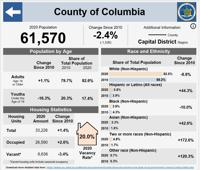Columbia County lost more than 1,500 residents over the last decade, the city of Hudson alone lost more than 800, or a 12.2% decrease.
Most municipalities in the county lost population, with Hudson losing the most and New Lebanon’s gaining the most at 9.1%, according to 2020 U.S. Census data and an interactive map released by the New York State Comptroller’s Office.
“The 2020 Census results show that New York state is changing, and this report and online tool provides detailed information about population changes in local communities and what it may mean down the road,” said New York State Comptroller Thomas P. DiNapoli. “These changes can impact how revenues, such as local sales tax and federal aid, are distributed.”
Columbia County’s population dropped from 63,096 in 2010 to 61,570 in 2020, a difference of 1,526.
“The modest decrease in population has certainly been anticipated, based on Census data collected over the 10-year period,” Columbia Economic Development Corporation President F. Michael Tucker said. “It was surprising to see the number of people under 18 years of age drop by 34% with the population over 65 increasing by 36%, while the 18 to 35 population remained virtually unchanged.”
Columbia County Board of Supervisors Chairman Matt Murell said a number of factors could influence the countywide changes.
“We’re a much older population than we had been. All you have to do it look at the school census numbers to see that we have a lot less kids going to school than we used to years ago, even 10 years ago. I think that’s part of it. The other part of it is, people to some degree are moving out of New York state for warmer climates and less taxes,” Murell said.
Since 2010, Hudson’s population under the age of 18 has dropped 26.5%, according to the census data. The city’s Black non-Hispanic population has also tumbled by 39%. The city’s total population is 5,894.
Hudson Mayor Kamal Johnson said the city’s decline in population could in part be attributed to the ongoing housing crisis. Johnson said in August that the school district’s student population has also been declining.
“I think it’s extremely alarming,” Johnson said. “It kind of goes hand-in-hand with what myself and a lot of housing activists have been saying all along, about us losing some of our families who have been rooted here. When that happens we also lose important services. We’ve seen the hospital have to close its birthing center, which causes a lot of issues across the county,” Johnson said.
Housing Justice Director Michelle Tullo recently presented a housing report to the Common Council detailing the need for affordable housing. “Affordable” is defined as residents not having to spend more than 30% of their income on rent.
“The big gap we have in the city is for people who are moderate-to-low income. So that’s what I mean by affordable. And so we now have this plan that says, ‘We know we have these housing issues, we have this need. So where can we actually build housing?” Tullo said.
Tullo said 1,000 households are paying more than 30%, meaning they are susceptible to housing insecurity, according to a report on the city from Hudson Valley Patterns for Progress.
“We’re a pretty small city, so 1,000 households is pretty huge,” Tullo said. “And people who qualify for housing aren’t able to get it because it’s not here. Our section eight housing voucher list has 245 households. And so that just shows that we actually do need more units.”
New Lebanon boasted a 9.1% gain over the last decade, bringing its total population to 2,514, according to the census data. The number of people under the age of 18 also increased by 13.4%. The town’s racial and ethnic diversity boomed over 10 years, with the number of people who identify as two or more races increased from 22 to 134 people.
The town of Greenport’s population increased by more than 7% with the addition of 308 people.
Although the county as a whole has lost residents, area officials said it is a vexing statistic as second-home owners have flocked to the county.
“It’s an interesting statistic, because we’ve been very busy in regards to our deed recordings and mortgage recordings in the office over the past year,” said Columbia County Clerk Holly Tanner. “So to hear that we actually lost population seems contrary to that. We’ve seen an increase in full-time residents, so it seems contradictory.”









